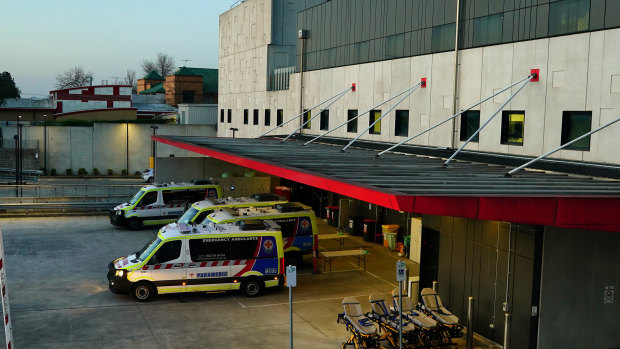
Save articles for later
Add articles to your saved list and come back to them any time.
Levy a modicum of pressure at any point in Victoria’s health system, and bottlenecks and boilovers arise elsewhere.
From delays in general practice and primary care, to the chronically stressed hospital system. From years-long waits to obtain specialist care, to inconceivably difficult and unacceptable conditions in aged care and disability care. From delays in ambulance attendance, to the hours ambulances spend
waiting to offload patients at hospitals.
Paramedics at work at Box Hill Hospital.Credit: Luis Ascui
A blockage at one point infects the whole system. Add in the eternal wrestle over state and federal funding systems, the public-versus-private care dynamic, the vested interests, the political power plays, and you are left to wonder where the patients stand in all this.
As The Age’s dedicated health journalists have reported in detail, there are chronic, dangerous and unattended crises in the state’s health system. Many have been apparent for decades, and the answers are neither obvious nor simple.
But it is absolutely unacceptable for suspected stroke or heart attack patients to be spending more than an hour on ambulance trolleys awaiting critical diagnosis and treatment. Or for more than 1400 people to be stuck in Australian hospitals waiting for the National Disability Insurance Scheme to unclog its bureaucratic delays and arrange appropriate housing and care.
Nor is it acceptable for ambulance crews to be idling for hours, unable to attend to other emergencies because they are queueing to get seriously ill patients into hospital emergency departments.
Ambulance ramping is ferociously expensive in terms of productivity and taxpayer dollars, and it is potentially dangerous for patients, having been linked to increased risk of death or readmittance to hospital.
These situations emerge, though, because Victoria’s hospital emergency departments are dreadfully overcrowded, which, in turn, is blamed on delays in transferring stabilised patients to beds in wards or other appropriate care.
Some emergency department practitioners blame staffing levels inside the unit and in the hospitals; others say the space constraints in hospitals are too limited. The issues raised by the Victorian Ambulance Union when it met the state’s health minister in May constitute only a smattering of concerns in one corner of the complex industry.
Bottlenecks are also due to many Victorians wasting the time and resources of the emergency public system when they have relatively minor complaints that could be treated by general practitioners.
Almost 2 million people attended the state’s hospital emergency departments in 2021-22, and the time they spend waiting before they are seen by a doctor or nurse can run to several hours.
To be fair, some people say they cannot afford to see GPs, whose overheads and wage costs have increased, and who now face the prospect of a payroll tax levied by the state government. But there can also be lengthy delays simply getting appointments with local doctors.
Victoria’s population has increased 50 per cent since 2000 – well beyond forecasts – and the demographic is ageing, which means the health system is dealing with more chronic-illness cases and more people needing constant care.
The public perception of hospital emergency departments has also changed: many people now presume it is their right to be treated at any time and for any ailment in a unit that until recent years was solely an elite and acute-care department. Healthcare has become more complex, people expect more, and we are living longer.
The healthcare service data, though, just keeps getting worse. More GPs and allied health professionals – the kind, for example, who might fit someone for a walking frame so they can be discharged from hospital – are desperately needed out of hours, at weekends and in regional areas.
Australasian College for Emergency Medicine president Dr Clare Skinner says
the system is “crumbling”. We agree.
The pandemic truly broke an already strained health system, and it is no longer a matter of hoping it will recover.
Healthcare is an inherently complex and multi-faceted industry that must have each element working closely and in synchronisation if it is to work properly. Tossing in more funds to fix isolated problems provides only temporary patches.
These patch-ups will not alleviate ramping and overcrowding. People need easier access to GPs to help them avoid emergency care, and NDIS-related bed block must be alleviated. Hospital capacity must also be improved. Solutions will require further investment, but also better co-ordination between the federal and state governments that control these systems.
We must end the continual blame-shifting between state and federal governments. Only by working together will long-lasting, practical and effective changes be achieved.
Patrick Elligett sends an exclusive newsletter to subscribers each week. Sign up to receive his Note from the Editor.
Most Viewed in National
From our partners
Source: Read Full Article
